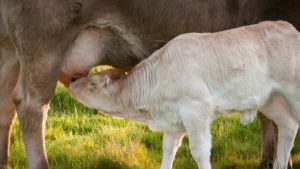What are our heifer breeding goals?
- Be well-grown
- Get in calf at the start of the breeding season
- Be structurally large enough to calve with minimum difficulty
What can we do to reach these goals?
Targets for heifers at service tend to be defined in terms of age and body weight as both of these are important factors affecting cyclicity. Whilst we cannot impact age and most heifers will reach puberty at 12-14 months we can affect body weight and should be aiming for heifers to be at 65% of their mature body weight at service. If serving at 15 months, this sets the average daily live weight gain at around 0.85kg from birth so careful management is essential. Regular weighing should be performed to allow you to ascertain if heifers are on track or not and make alterations if required.
Heifers should be getting in calf at the start of the breeding season to allow them to calf at the start of the calving block. This will allow the heifer extra time to recover before the start of the next mating season and return to cyclicity. It gives the option to manage heifers as a separate group which can help limit social stress as well as meaning this group can be monitored closely around calving in case of any difficulties. By removing heifers not in calf at the start of the breeding season we are also retaining the most fertile animals for the herd.
Pre-breeding examinations of heifers can be a useful tool to ensure heifers calve at the start of the block. A pre-breeding exam allows heifers to be checked to ensure that no free-martins have made it through to service, that there are no ‘surprise’ in calf heifers and that they are cycling. A pre-breeding exam should involve reproductive tract scoring and can be an opportunity to synchronise heifers too.
Reproductive tract scoring indicates how well an animal is cycling. It involves palpating the heifer reproductive tract (uterine horns and ovarian structures) and assigning a score depending on the tone of the uterus and what structures are present. Scores range from 1 to 5 with lower scoring heifers less likely to be cycling and less likely to become pregnant. Non-cycling heifers can either be removed or reassessed but may require intervention in terms of nutrition or fertility products.
Synchronisation is another tool that can be used to ensure heifers calve early in the calving block. This involves manipulating the heifer’s normal cycle to get them bulling. There are a number of synchronisation protocols available that will differ in terms of cost and handling points. They are likely to involve a combination of prostaglandin, progesterone and Gonadotrophin Releasing Hormone (GnRH). Some of these protocols allow for fixed-time service and others will bring the heifer bulling over a particular time frame. Synchronisation will usually be used alongside artificial insemination, which brings its benefits – allowing access to bulls of high genetic merit and estimated breeding value (EBV) data, less bull power needed and less concern about potential inbreeding! It also allows more control over the calving block so focuses the need for labour into a smaller period.
Unsurprisingly, one of the most common problems associated with calving is foetal maternal disproportion where either the dam is too small or the calf is too large (or both!). Whilst we will all be aware that bull selection is important in terms of targeting a smaller calf, there are also criteria we can apply to heifers to ensure that pelvic size will be adequate at first calving.
Pelvimetry allows us to measure the internal pelvic size of the heifer using a measuring device called a Rice’s Pelvimeter. Once the internal height and width have been taken, they are multiplied to calculate an overall area. There are then tables associated with the animals’ age and breed which allow an animal to be assigned a pass, borderline or fail. Pelvimetry should be performed in bulling heifers between 13-24 months as the pelvis is growing consistently at that time. Any heifers with small pelvises can then be removed prior to service.
By Rebecca Cavill BVetMed CertAVP (Cattle) PgCert MRCVS, Torch Farm Vets
For further information on maximising your suckler herd, get in touch with your NWF Sales Specialist or click HERE to view our Beef Feeds & Associated Products.

